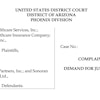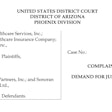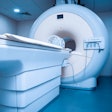
Medical malpractice claims that allege radiological errors are common: In fact, radiology is No. 2 on a list of medical specialties most likely to be sued, according to a report released on August 14 by medical liability insurer Coverys. Fortunately, there are several simple ways your practice can protect itself.
"[Radiology practices must] get ahead of the risks, allowing them to take proactive steps to avoid harm from actually reaching the patient," the report states. "Malpractice data ... can provide 'signal intelligence' for potential risks in radiology departments that might not be on the radar of care team members and risk managers."
Missed diagnosis
Coverys examined more than 10,000 medical professional liability claims from between 2013 and 2017 to identify risks that radiology practices can actively address. It found that radiologists were involved in 15% of diagnosis-related medical professional liability claims, second only to primary care physicians at 24%.
 Bob Hanscom, Coverys' vice president of business analytics.
Bob Hanscom, Coverys' vice president of business analytics."We have four claim areas that have been fairly active for the past two decades: diagnosis, surgery, medication errors, and obstetrics," Bob Hanscom, Coverys' vice president of business analytics, told AuntMinnie.com. "Medication error and obstetrics claims have consistently declined, and surgery claim rates are also somewhat lower. But diagnostic claim frequency hasn't improved at all and in some cases has increased."
Within the diagnostic claims category, 80% of missed diagnoses are purported to have been due to misinterpretation of clinical tests; cancer diagnoses are the most frequent of these, with breast, lung, pancreatic, and ovarian cancers as the top four. More than 80% of missed diagnosis claims involve permanent injuries to the patient or death, Coverys found.
"As radiologists seek to work in a more collaborative fashion with ordering physicians, they are more vulnerable to getting pulled into liability cases -- especially since plaintiff attorneys have gotten savvier about identifying any physician who provided care for the patient," Hanscom said.
Risk assessment
Hanscom said there are three diagnostic areas that particularly open up radiologists to liability:
- Exam interpretation
- Understandability of the report
- Follow-up of incidental findings
"The primary care provider relies on the radiologist interpretation of the exam, and if there's an error, it will often fall back on the radiologist in a claim," he said. "As for radiology reports, they can be lengthy, with findings buried so that the ordering physician misses key information. And finally, incidental findings need to be communicated not only to the ordering provider but also to the patient's primary caregiver."
Coverys' data suggest a number of questions radiology practices could use to assess risk, including the following:
- Is there a system in place to identify outstanding test results and follow-up studies?
- Is there a process for communicating test results during transitions of care between the inpatient and outpatient settings?
- Are electronic health records sending abnormal test results to both ordering and primary care providers?
- Are there processes in place to prompt communication of the urgency of a recommended imaging study or other intervention?
"In the long run, putting into place best practices will help improve patient outcomes while helping radiologists on two additional key fronts: reducing malpractice exposure and maximizing revenue," according to the report.
8 ways to manage risk
Coverys offered eight ways for radiology practices to manage liability risk:
- Use decision-support tools and standard treatment protocols to manage workflow.
- Develop criteria to determine whether a second read of an exam must be performed, including the time frame for completing it. "The process should include confirmation back to the radiologist that the second read has been received," the report states.
- Develop report templates that require notation of particular elements, such as suspected problems, issues that have been ruled out, and probable diagnoses and recommendations. "Report templates can help radiologists communicate findings in crystal clear language to avoid any ambiguity," Hanscom said.
- Separate incidental findings from the rest of the report, or highlight them within the report.
- Apply appropriate use criteria or other exam guidelines at the point of the exam order.
- In facilities with teleradiology, regularly evaluate image and transmission quality.
- Revise practice standards as technology evolves (for example, shifting to digital or from 2D to 3D).
- Regularly assess peer-review practices to ensure they effectively measure staff performance.
The bottom line is that there are many fairly simple ways to protect one's practice from liability risk, from developing report templates to using processes such as peer review to reduce interpretation variability, according to Hanscom.
"Radiologists are increasingly engaging with patients, and although that offers opportunities for collaborative healthcare, it also makes them more vulnerable to liability," he said. "It's important that radiology be active and innovative as it develops strategies for providing the best possible care."




















